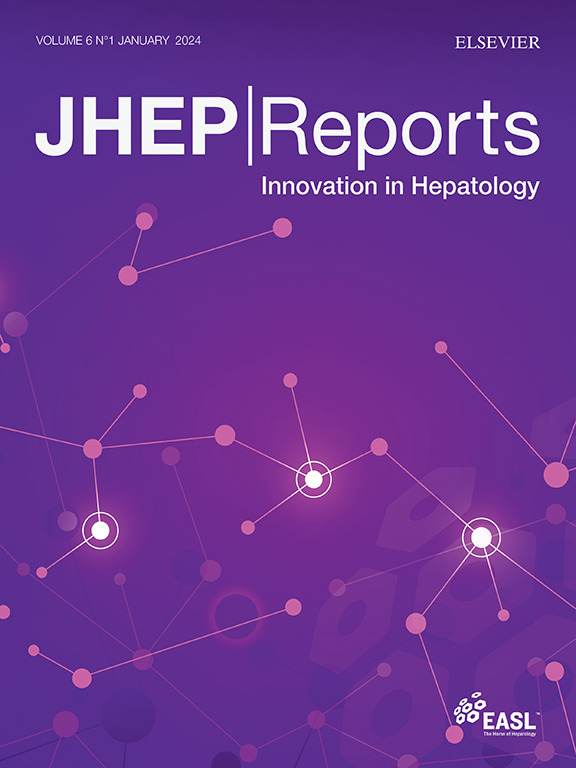髓样TGF-β信号影响肝巨噬细胞异质性和代谢性肝病的发病机制
IF 7.5
1区 医学
Q1 GASTROENTEROLOGY & HEPATOLOGY
引用次数: 0
摘要
背景,肝脏中先天免疫细胞(如巨噬细胞)的细胞异质性是代谢功能障碍相关脂肪性肝炎(MASH)发病机制的一个标志。然而,在疾病进展过程中形成肝巨噬细胞异质性和功能的机制仍然知之甚少。方法对照组或骨髓特异性Tgfbr1基因敲除小鼠(每组n = 9-12)饲喂12周的胆碱缺乏、氨基酸定义的高脂肪饮食(CDA-HFD)或20周的GAN饮食(40%脂肪、22%果糖、2%胆固醇)。采用组织病理学、定量PCR、免疫印迹、流式细胞术和RNA测序(RNA-seq)对肝组织进行分析。进行大量RNA-seq(每组n = 3)和单核RNA-seq来研究转录重编程。采用流式细胞术和免疫荧光法观察巨噬细胞种群动态。结果:我们发现TGF-β信号是MASH肝脏中Trem2+和Fcrl5+巨噬细胞疾病相关扩张的关键调节因子。小鼠骨髓特异性Tgfbr1失活加剧了饮食诱导的MASH,增加了肝细胞损伤、炎症和肝纤维化。在机制上,髓细胞中TGF-β信号的缺失改变了巨噬细胞的组成,其标志是Trem2+的减少和Fcrl5+巨噬细胞的扩增。此外,缺乏Tgfbr1的巨噬细胞表现出与炎性体激活、细胞因子信号传导、细胞衰老和免疫抑制相关的基因特征。这些巨噬细胞组成和功能的变化促进了tgfbr1缺陷小鼠中效应T细胞的衰竭和msh相关肝细胞癌的发展。结论髓系TGF-β信号是微环境中肝巨噬细胞异质性和极化的关键驱动因素,在MASH和MASH相关肝癌的进展过程中。影响和意义我们的研究表明,骨髓TGF-β信号在形成肝巨噬细胞异质性中起着至关重要的作用,从而影响代谢性肝病的发病机制。这些发现对于研究免疫代谢相互作用的研究人员和寻求肝脏疾病新治疗策略的临床医生尤其重要。通过阐明TGF-β信号如何调节巨噬细胞功能,我们的工作为调节免疫反应以改善肝脏健康的靶向干预铺平了道路。未来的研究应考虑这些发现的潜在转化应用,同时解决与模型系统和人类可变性相关的局限性。本文章由计算机程序翻译,如有差异,请以英文原文为准。

Myeloid TGF-β signaling shapes liver macrophage heterogeneity and metabolic liver disease pathogenesis
Background & Aims
Cellular heterogeneity of innate immune cells, such as macrophages, in the liver is a hallmark of metabolic dysfunction-associated steatohepatitis (MASH) pathogenesis. However, the mechanisms shaping liver macrophage heterogeneity and function during disease progression remain poorly understood.
Methods
Control or myeloid-specific Tgfbr1 knockout mice (n = 9-12 per group) were fed a 12-week choline-deficient, amino acid-defined high-fat diet (CDA-HFD) or a 20-week GAN diet (40% fat, 22% fructose, 2% cholesterol). Liver tissue was analyzed using histopathology, quantitative PCR, immunoblotting, flow cytometry, and RNA sequencing (RNA-seq). Bulk RNA-seq (n = 3 per group) and single-nucleus RNA-seq were performed to investigate transcriptional reprogramming. Macrophage population dynamics were evaluated by flow cytometry and immunofluorescence.
Results
We identified TGF-β signaling as a crucial regulator of disease-associated expansion of Trem2+ and Fcrl5+ macrophages in MASH livers. Myeloid-specific inactivation of Tgfbr1 in mice exacerbated diet-induced MASH, with increased hepatocyte injury, inflammation, and liver fibrosis. Mechanistically, loss of TGF-β signaling in myeloid cells altered macrophage composition, marked by a reduction in Trem2+ and expansion of Fcrl5+ macrophages. Additionally, macrophages lacking Tgfbr1 exhibited gene signatures associated with inflammasome activation, cytokine signaling, cellular senescence, and immunosuppression. These changes in macrophage composition and function promoted effector T cell exhaustion and the development of MASH-associated hepatocellular carcinoma in Tgfbr1-deficient mice.
Conclusions
These findings identify myeloid TGF-β signaling as a key driver of liver macrophage heterogeneity and polarization within the microenvironment during the progression of MASH and MASH-associated liver cancer.
Impact and implications
Our study reveals that myeloid TGF-β signaling plays a crucial role in shaping liver macrophage heterogeneity, which in turn influences the pathogenesis of metabolic liver disease. These findings are particularly important for researchers studying immune-metabolic interactions and for clinicians seeking new therapeutic strategies for liver disorders. By elucidating how TGF-β signaling regulates macrophage function, our work paves the way for targeted interventions that modulate immune responses to improve liver health. Future research should consider the potential translational applications of these findings while addressing limitations related to model systems and human variability.
求助全文
通过发布文献求助,成功后即可免费获取论文全文。
去求助
来源期刊

JHEP Reports
GASTROENTEROLOGY & HEPATOLOGY-
CiteScore
12.40
自引率
2.40%
发文量
161
审稿时长
36 days
期刊介绍:
JHEP Reports is an open access journal that is affiliated with the European Association for the Study of the Liver (EASL). It serves as a companion journal to the highly respected Journal of Hepatology.
The primary objective of JHEP Reports is to publish original papers and reviews that contribute to the advancement of knowledge in the field of liver diseases. The journal covers a wide range of topics, including basic, translational, and clinical research. It also focuses on global issues in hepatology, with particular emphasis on areas such as clinical trials, novel diagnostics, precision medicine and therapeutics, cancer research, cellular and molecular studies, artificial intelligence, microbiome research, epidemiology, and cutting-edge technologies.
In summary, JHEP Reports is dedicated to promoting scientific discoveries and innovations in liver diseases through the publication of high-quality research papers and reviews covering various aspects of hepatology.
 求助内容:
求助内容: 应助结果提醒方式:
应助结果提醒方式:


